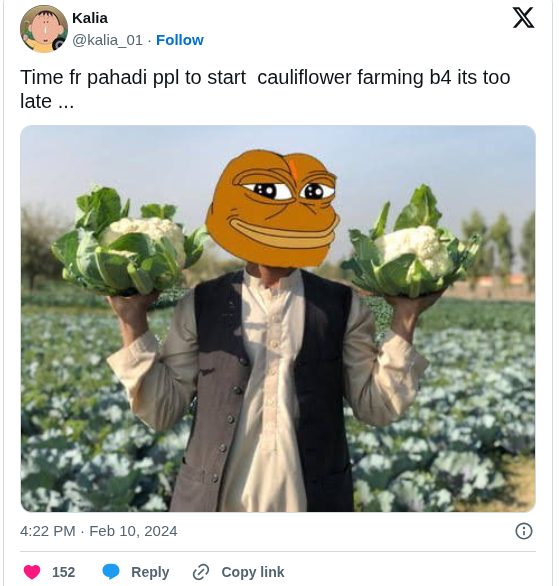After Maoist deaths, BJP Karnataka shares ‘cauliflower’ meme, a reference to the 1989 Bhagalpur riots
On May 23, two days after security forces killed several Maoists in Chhattisgarh, the X handle of BJP Karnataka (@BJP4Karnataka) posted an animated image of Union home minister Amit Shah with a cauliflower in his hand, resting his arm on a tombstone that said, “Naxalism Rest in Peace”. (Archive)
The image was captioned, “Lol” Salam, Comrade,” a pun on communists’ usage of the greeting “Lal Salam” or red salute.
On May 21, 2025, the District Reserve Guard unit of the Chhattisgarh police, a special force created to combat insurgency in Chhattisgarh, carried out an anti-Naxal operation in the state’s Narayanpur district. 27 Maoists, including the general secretary of the banned Communist Party of India (Maoist), Nambala Keshav Rao, alias Basavaraju, were neutralised in this. Named Kagar, this operation sought to neutralise Maoist presence in the Karreguttallu hill range along the Telengana-Chhattisgarh border region.
The May 23 post by the BJP handle was in response to a statement by the Communist Party of India (Marxist-Leninist) Liberation (@cpimlliberation) condemning “the cold-blooded extra-judicial killing of the General Secretary of CPI(Maoist) Comrade Keshav Rao and other Maoist activists and Adivasis in Narayanpur-Bijapur.” Calling it a massacre, the communist party said, that “celebratory” posts by Indian leaders made it clear that the state was carrying out “an extra-judicial extermination campaign and taking credit for killing citizens and suppressing Adivasi protests against corporate plunder and militarisation in the name of combating Maoism.” The party was likely referring to X posts by Shah and Prime Minister Narendra Modi, who hailed the Maoists’ deaths as a “landmark achievement in the battle to eliminate Naxalism”.
In the past 16 months, under the BJP’s governance, more than 400 alleged Maoist insurgents have been killed in Chhattisgarh, a state with a significant Adivasi population.
While the two parties and their ideologues are on two opposing ends on how they view the Naxal movement, the troubling part is that BJP Karnataka’s X post used a trope—the cauliflower—that is a horrifying reminder of a genocide.
Rooted in Bloodshed
To an unsuspecting viewer, Shah holding a cauliflower on the tombstone of the Naxal movement might strike as odd, but harmless. However, the cauliflower here is a deep-rooted symbol of bloodshed. It is a reference to the 1989 Bhagalpur riots in which over a 100 Muslims were killed.
Over 35 years ago, a series of brutal riots broke out in the city of Bhagalpur, Bihar. In October, 1989, rumours of Hindu students being murdered by Muslim mobs amid the cultural furore of the Ram Janmabhoomi movement began spreading. This gave way to a protracted period of organised communal violence, lasting around two whole months. The Bhagalpur riots, as they are called, saw more than 250 villages razed to the ground, leaving well over a thousand people dead, majority of them Muslims.
But something far more sinister took place in Bhagalpur’s Logain village. On October 27, 1989, a mob, allegedly led by police officer Ramchander Singh, killed 116 Muslims. Their bodies were buried, and cauliflower saplings were sown on their mass graves to cover up the killings.
Nearly 25 days later, on November 21, the then-Additional District Manager of Bhagalpur, AK Singh, on a relief mission to a nearby village, overheard conversations between villagers about cauliflower plants sprouting over buried dead bodies and unearthed the massacre. Another account suggests that Singh found out that bodies may be buried under the ground because he saw vultures hovering above the cauliflower plantations.
For more details on the happenings in 1989 and what triggered the clashes, read our earlier report here. You can also read the Bhagalpur Riot Inquiry Commission Report here.
The Cauliflower Imagery
While the Bhagalpur riots took place over three decades ago, in the past few years, the cauliflower symbolism has found its way through graphical representations, imagery and memes. Each time, a minority or non-Right group is targeted, supporters who identify with Hindutva groups or the Right-wing ideology have openly made references to the cauliflower as a ‘solution’.
In March 2025, after communal clashes broke out in Maharashtra’s Nagpur, Right-leaning social media users referred to cauliflowers, as a potential ‘solution’.
Click to view slideshow.
In February last year, similar cauliflower references were used in several social media posts after riots broke out in Haldwani.

Several memes were made and shared on social media platforms glorifying the Bhagalpur massacre, subverting a horror as a feasible remedy.
Read | Nagpur clashes: Cryptic cauliflower memes referring to mass killings in 1989 Bhagalpur riots resurface
Not only does such symbolism trivialize the horrors of what unfolded in Bhagalpur but glorifies the action as an acceptable ‘solution’. It’s hard to determine which is more troubling, that the state wing of a party that governs the nation shared this or that “eliminating Naxalism” is being equated to a genocide. As of May 24, despite several social media users pointing out the gory undercurrents to the image, BJP Karnataka’s X handle has not taken the post down.
The post After Maoist deaths, BJP Karnataka shares ‘cauliflower’ meme, a reference to the 1989 Bhagalpur riots appeared first on Alt News.
News